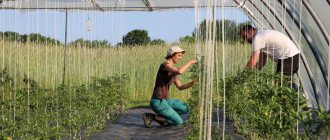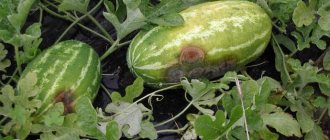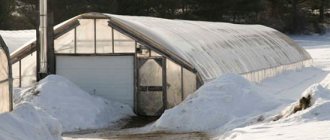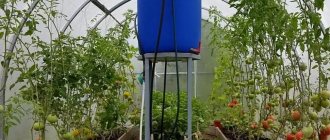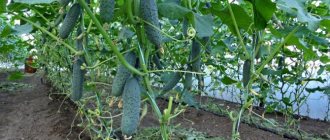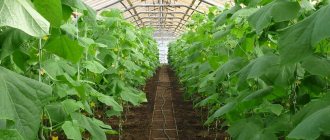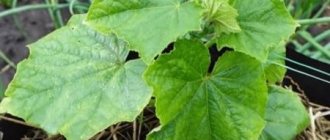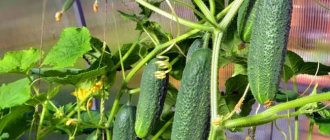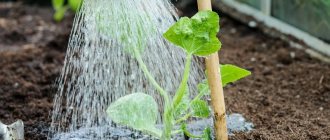Cucumber harvesting is possible in several cultivation methods, which mainly depend on climatic conditions and the availability of cultivation area. Don’t be upset if you don’t have a plot of land or your region of residence is too cold. Try growing cucumbers in buckets. We'll talk about how to do this later in the article.
What varieties of cucumbers are suitable for growing in buckets?
When choosing a variety of cucumbers for growing them in cramped spaces, choose those whose root system does not branch much during growth and takes up little space. Otherwise, the plants will not have enough nutrients due to inhibition and stunting of root growth. Therefore, pay attention to bush and short-stemmed varieties of cucumbers (“Bush Dar”, “Mikrosha”, “Kustovoy”).
It is advisable to plant parthenocarpic or self-pollinating cucumbers (“Akter”, “Hermes F1”, “Abbot”) in buckets. This gives them the opportunity to not depend on pollinating insects and weather conditions. The formation of ovaries in a parthenocarpic species occurs without pollination, and self-pollinating varieties do not require assistance in this process.
To cultivate in this way, choose seeds of varieties and hybrids sold in factory packages. This guarantees that the seed material truly belongs to this varietal species and has undergone pre-planting preparation.
When planting your seeds, pay attention to the fact that the most productive will be those that are stored for at least 2 years.
Watering
To avoid excessive stretching of the stems, do not water the seedlings heavily. Water through the holes in the bottle installed inside will gradually moisten the soil, and the excess will leave through the drainage. It is necessary to monitor the humidity level and avoid stagnation of water, otherwise the roots will rot and the plant will die.
Related article:
Cucumber Emerald earrings F1 - description and characteristics of a high-yielding early-ripening hybrid
Due to the fact that cucumbers are grown in limited conditions - buckets, mulching the soil is recommended. Additional cover with straw or mowed grass will help prevent rapid loss of moisture and drying out of the soil.
For irrigation, it is better to use warm water, standing for several days. After the procedure, you can slightly loosen and hill up the stem.
It is also practiced to water in a tray and spray the leaves with a spray bottle.
Advantages and disadvantages
Harvesting cucumbers by growing them in buckets has its positive and negative sides. The advantages of the method include:
- the possibility of cultivation in an apartment in the absence of a plot of land;
- independence of location and the ability to move containers with cucumbers;
- individual care for each plant;
- independence from predecessors, lack of importance of crop rotation;
- early fruiting;
- cucumbers are environmentally friendly due to minimizing the need to use chemicals;
- convenience in agricultural technology and harvesting.
The only disadvantage of this method is that the number of cucumber roots when grown in buckets cannot be large. This means that the harvest will not be able to fully satisfy the need for consumption of fresh vegetables and their canning. With a large number of plants, this method becomes labor-intensive and unprofitable.
Sowing
To obtain favorable germination, the seeds must first be soaked for 12 hours. It is recommended to use various drugs to stimulate growth (for example, Epin, Zircon) or plain water (boiled, cooled). Also, many gardeners practice germination in damp gauze or on a cotton pad, as well as disinfection in a weak solution of potassium permanganate. Later, the seeds are laid out to dry on a sheet of paper towel or napkin.
Many manufacturers sell seeds that have already been treated with specialized preparations and do not require soaking. Therefore, before sowing, you must carefully study the information on the packaging.
Prepare a hole, place 4-5 seeds at an equal distance, sprinkle with a little soil. To create optimal conditions for germination (minimum +18 degrees Celsius, required humidity), the planting is covered with glass or film.
After the sprouts have become stronger, in order to obtain high-quality lighting, the bucket is placed on the south or eastern side of the site.
To form a compact bush and wattle fence, many gardeners install small trellises and various supports made of metal, wood or plastic in containers. This way the stem can be evenly distributed throughout the entire structure, which will greatly facilitate cultivation, care and harvesting. The recommended time for work is the presence of full 5-6 leaves.
The most extraordinary and enthusiastic summer residents can surprise others with an alternative method of planting cucumbers. The soil is prepared in a bucket, but the layers are alternated in the opposite way than in the method described above. That is, below is soil, above is drainage. Cover with a lid or several layers of film and tie with twine. Turn it over, cut several holes with a diameter of 5 cm in the bottom. Plant seeds in these slots. After the plant becomes stronger, 4-5 leaves appear, the container is hung like a flower pot.
The stems may not be able to cope with the weight of the fruit and break off; watering and fertilizing are also difficult.
Features of cultivation
To use the method of cultivating cucumbers in buckets, you should know about its features in order to be able to avoid mistakes or correct them at an early stage.
Selection and preparation of a bucket
For this cultivation method, any containers with a volume of more than 5 liters are suitable. Give preference to containers made of wood. Plastic buckets need to be improved before planting: make several drainage holes in the sides and bottom. Options for landing containers can be:
- old buckets;
- cut canisters;
- plastic containers;
- barrels;
- large plastic bags;
- old car tires, etc.
When planting cucumbers, give preference to buckets with a sufficiently wide diameter so as not to accidentally damage the plant during agricultural activities. Be sure to place a drainage layer of expanded clay or river stones at the bottom of the container.
Soil preparation
Purchase planting mixture for cucumbers at the store, or prepare it yourself. The ideal option for this vegetable crop is soil obtained by mixing the following components in equal proportions:
- sand;
- humus;
- manure;
- turf.
Remember that self-prepared soil needs disinfection. To do this, place it in the oven for 20 minutes at 200°C. Such measures are necessary to prevent fungal infections of cucumbers, the source of which can be any of the ingredients in the soil mixture.
To saturate purchased planting soil with microelements and nutrients, apply any complex fertilizer. Dilute 10 g of fertilizer in 10 liters of water and water the soil at the rate of 1 liter of nutrition for each 10-liter container.
Sowing cucumbers
Having decided on the container, prepared the soil and purchased cucumber seeds, you can start planting. If the planting material is from personal reserves, it is recommended to carry out pre-sowing treatment and disinfection.
Prepare a slightly pink solution of potassium permanganate and dip the seeds in it, wrapping them in a layer of gauze for 15-20 minutes. Afterwards, rinse them with clean running water.
The action of manganese will destroy fungal spores, if any, which will prevent the occurrence of diseases during the growing season of cucumbers.
Before direct planting, it is recommended to calibrate and germinate the seeds. Select the largest specimens and place them in a saucer on cotton cloth or gauze. Pour warm water on top so that it covers the seeds. Cover with a layer of cloth and make sure that it does not dry out. Leave until sprouts appear. Afterwards, carefully rinse and dry slightly so that it is convenient to use when planting.
Follow the following landing algorithm:
- In each bucket, placed on the east or south side, plant 3-5 cucumber seeds, deepening them 3 cm into the soil.
- If they all sprout, they can be planted using picking.
- After sowing, water moderately.
- To maintain the level of moisture in the ground, you can place a plastic bottle filled with water in a bucket, making small holes in it.
After the shoots emerge, install supports for the vines. These can be wire arcs or stretched ropes attached to a central support. The choice of support structure depends entirely on the capabilities and imagination of the gardener.
About the features of growing cucumbers in buckets, see the following video:
Prepare the seedlings
| Treat seeds before planting First of all, soak in a solution of potassium permanganate. It will kill all viruses if they were on the shell. Then soak in Fitosporin solution . It will increase resistance to adverse conditions | |
| Germinate seeds Place the seeds in gauze or between cotton pads. Moisten the material generously and place in a warm place. Monitor the moisture content of the material daily . Moisten if necessary. After the sprouts appear, you can harden the seeds by placing them overnight on the bottom shelf of the refrigerator. | |
| Plant cucumbers It is most convenient to place them in separate containers. Peat cups are great because you can then plant plants with them. Large containers can be used . Plant seeds at a distance of at least 3 cm from each other | |
| Caring for seedlings Place in a bright place. But protect from drafts. Water and feed the plants . Spray with moisture in the mornings and evenings |
Caring for cucumbers in buckets
Agricultural technology and care for cucumbers cultivated in buckets are somewhat different from other growing methods. For example, bushes do not need to be formed using the pinching method, because with the right choice of seeds, the vines do not grow long. Weeding is excluded, because weed seeds are destroyed with proper soil preparation. All this makes it easier to care for the vegetable crop as it grows and the fruits ripen.
Caring for cucumbers in buckets involves ensuring the following conditions:
- A sufficient amount of light for the crop will ensure that the buckets are located on the sunny side. Use lights if necessary, especially during the seedling growth stage.
- Do not allow the soil in the containers to dry out. Watering in a limited container is needed more often, because moisture evaporates and is consumed faster than under normal growing conditions. Water for irrigation should be warm.
- Sprinkle. Cucumbers really love this procedure and react positively to it.
- Loosening the soil will increase aeration, preventing fungal diseases and saturating plants with oxygen. Sprinkle additional soil around the stem as needed or mound it with existing soil so that the roots are not exposed.
- When the ovaries form, feed the cucumbers with ash infusion. To prepare it, dissolve 100 g of wood ash for each liter of water. Leave the composition for a day, and then carry out root feeding of the crop.
About gartering cucumbers in buckets, watch the following video:
Pros of a closed root system
Professional gardeners highlight many advantages of this method. They include:
- Easy care. It is enough to regularly water the vegetable crop and carry out preventive spraying to prevent the attack of harmful insects and fungal infections;
- The plant is evenly illuminated from all sides by sunlight;
- The container with plantings can be moved around the dacha area;
- You can harvest the crop 2 weeks earlier than with the traditional method;
- To maintain the vital parameters of the plant, it is enough to use a minimum of fertilizers;
- A closed root system allows you to develop good immunity. Thanks to this, the vegetable crop is less susceptible to various diseases;
- Crispy fruits do not come into contact with the ground cover.
It is recommended to leave plant residues for the winter. Thus, the soil substrate will become looser and fertilized with organic fertilizer.
Harvesting cucumbers
Cucumbers are collected as needed. The frequency of harvesting ripe fruits depends on the size of cucumbers needed and the yield of the variety. The harvest is harvested early in the morning or in the evening after sunset.
When harvesting, be careful, because leaving the fruits on the vines leads to overripening and yellowing of the cucumbers, which reduces the formation of new ovaries.
Check the presence of greens daily, and collect them at least once every 2-3 days. At the same time, try not to twist the vines so as not to injure them. Remove deformed fruits immediately so that the crop does not waste its reserves of strength and nutrition on the useless growth of such a crop. Remove the cucumbers, leaving the stem on the plant.
Proper care
How to grow cucumbers:
- When the plant has flowers, carry out the first fertilizing . Apply fertilizer once a month.
- Water at least every other day . During hot periods, water daily. After watering, be sure to loosen the surface, or you can mulch it.
- Spray against diseases with biological preparations . Fitosporin and its analogues are excellent.
- When it's time to harvest, pick greens every day . This way the harvest will be much larger, since the plant’s resources are directed to the formation of new fruits.
Reviews from gardeners
★★★★★
Natalya, 47 years old, housewife, Adygea. I live in the south, but in an apartment.
I tried growing cucumbers this way for the first time last year. But out of ignorance, I made a number of mistakes: the containers turned out to be insufficient in volume, and the variety was chosen incorrectly. As a result, the harvest is small and there is a lot of hassle. I didn’t give up the method. This year I’m doing everything according to the rules! ★★★★★
Egor, 34 years old, builder, Omsk. For the first time, we planted cucumbers in buckets as an experiment with children.
We grew the hybrid “Cellar” on an insulated balcony. We were pleasantly surprised by the effectiveness of this method. Children now take part in planting every year and look forward to the harvest. ★★★★★
Julia, 41 years old, manager, Moscow region. I am generally a lover of flowers and vegetation.
It so happened that we have no free beds on our site. Planting cucumbers in buckets came to the rescue. Cucumbers have time to ripen, giving a decent harvest per season. An excellent alternative to store-bought fruits, bringing pleasure during cultivation and satisfaction after harvesting the fruits. Hide
Add your review
Cultivating cucumbers in buckets is not difficult; on the contrary, it gives an advantage where it is impossible to obtain a crop in any other way. The main thing is to take into account the needs of the crop, to properly prepare and organize the growing process itself. Cucumbers obtained “in a bucket” delight with their taste and aroma.
0
0
Copy link
Useful materials
Explore other useful articles about caring for cucumber seedlings:
- Tips for growing in various containers, in particular peat pots and tablets.
- The reasons why seedlings stretch out and their leaves turn yellow?
- All the secrets of picking young seedlings and planting them in open ground.
Selecting a location
Since cucumber is a light-loving and heat-loving crop, you need to choose a place for placing containers that is well lit and protected from the wind. It is better to place them on the south or southwest side. In regions with hot summers, it is undesirable for plants to be exposed to scorching sunlight all day. It is better to prudently place the barrels near trees that will provide partial shade in the heat. The branches can also serve as additional support for climbing cucumbers. If the containers are placed next to a gazebo or fence, the plants can be tied to them - this will be convenient and, to some extent, decorative.
Choose a place to install barrels of cucumbers that is well lit and protected from cold winds.
What will you need to germinate bushes?
In addition to planting material, for germination at home you need to take containers of a suitable size and pre-prepared soil.
Suitable soil
Soil from the garden is not suitable for growing cucumbers on the balcony. Such soil may contain pathogens or weed seeds. It is recommended to plant cucumbers in a soil mixture with complex fertilizers. To save money, you can take turf soil, along with peat, sawdust, ash and compost. Then 5 grams of phosphorus, potassium and nitrogen fertilizers should be added to the resulting mixture.
Soil preparation
You need to take care of filling the container in the autumn or early spring. In total, three layers of different composition and functions are placed in the barrel. The volume of each of them is approximately a third of the capacity. Layers contain the following components:
- The lower layer consists of plant residues and organic waste. Twigs, stalks of corn or sunflower, cabbage stumps are placed on the bottom - large plant remains perform a drainage function. Next, fallen leaves, weeds, straw, sawdust, peelings of vegetables and fruits, as well as other food waste are placed. To speed up the process of processing biomass into humus, the first layer can be treated with biodestructors (Compost, EcoCompost, Baikal EM and others). The bottom layer is best prepared in the fall. By spring, its components decompose, forming an excellent substrate for growing cucumbers.
First, the barrel is filled with plant debris and food waste.
- Fresh manure is ideal for the middle layer. During its overheating, a lot of heat is released and high humidity is created, which is necessary when growing early ripening cucumbers. If there is no manure, add small (quickly rotting) components of the first layer, mixing them with a small amount of fertile soil or humus.
- The last layer is a nutrient mixture, which includes soil, compost (or humus) and peat in equal parts. Instead of peat, you can put rotted sawdust or chopped straw. And also to improve soil aeration, you can add vermiculite, which is widely used as a mineral substrate in crop production. Its ability to easily absorb and release moisture helps maintain optimal soil moisture levels. You can also add 1–3 tablespoons of complex mineral fertilizer to the finished mixture. The top layer in which the root system will be located must be at least 25 cm.
The contents of the container are spilled with 30–40 liters of warm water and kept for at least 15–20 days, during which time the soil will settle. The distance from the level of the filled soil to the top edge of the barrel should be about 20 cm; if the soil settles to a great depth, it must be added.


